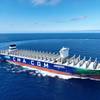Hapag-Lloyd Doubles EBIT for 9 Months
German international shipping and container transportation company Hapag-Lloyd said that its earnings before interest and taxes (EBIT) in the first nine months of 2019 significantly increased to EUR 643 million (9M 2018: EUR 299 million).
The group net result rose substantially to EUR 297 million (9M 2018: EUR 13 million). Earnings before interest, taxes, depreciation and amortization (EBITDA) surpassed EUR 1.5 billion (9M 2018: EUR 812 million). The EBITDA increase of EUR 699 million includes a positive effect of approximately EUR 341 million caused by the new reporting standards IFRS 16.
After the first nine months of the year, revenues rose to approximately EUR 9.5 billion (9M 2018: EUR 8.5 billion). The transport volume rose by 1.2 percent to 9,011 TTEU (9M 2018: 8,900 TTEU), and the average freight rate climbed by 4.2 percent to 1,075 USD/TEU (9M 2018: 1,032 USD/TEU). Transport expenses increased by 3.5 percent, in particular due to a slightly higher average bunker consumption price of USD 425 per tonne (9M 2018: USD 406 per tonne) and a stronger average US dollar exchange rate against the euro.
“We have achieved a very respectable result after nine months: Despite geopolitical tensions and trade restrictions, we benefitted from higher transport volumes and better freight rates and also kept a close eye on our costs. And the same holds true for our strategic goal of becoming number one for quality,” said Rolf Habben Jansen, Chief Executive Officer (CEO) of Hapag-Lloyd.
For the full financial year 2019, Hapag-Lloyd expects an EBITDA in the range of EUR 1.6 to 2.0 billion and an EBIT in the range of EUR 0.5 to 0.9 billion. Based on the business development in the first nine months of 2019, it can currently be assumed that EBITDA and EBIT will be in the upper part of the guided ranges.
This includes a currently expected earnings effect from the first-time application of the accounting standards IFRS 16 on EBITDA of EUR 370 to 470 million and on EBIT of EUR 10 to 50 million. The effects of the first-time application of IFRS 16 are also currently expected to be in the upper part of the guided ranges.













